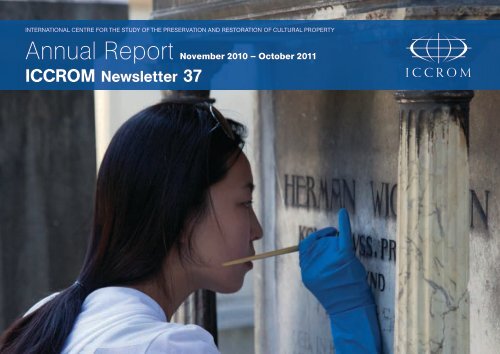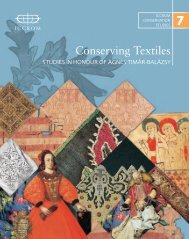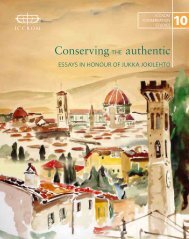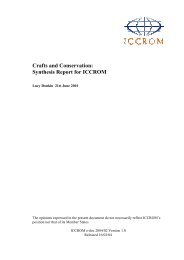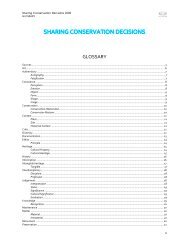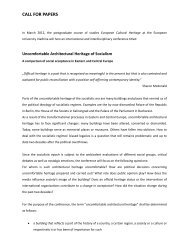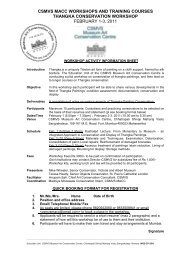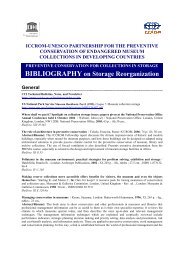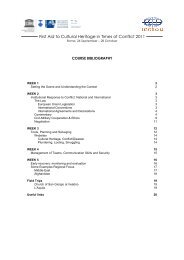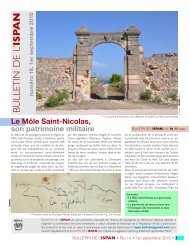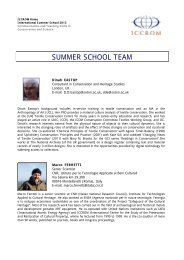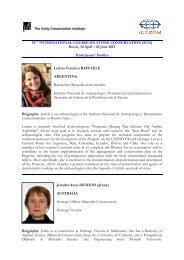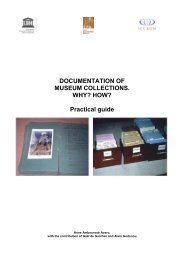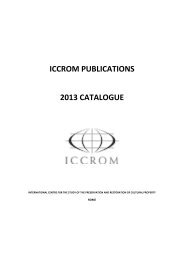Annual Report 2011 - Iccrom
Annual Report 2011 - Iccrom
Annual Report 2011 - Iccrom
Create successful ePaper yourself
Turn your PDF publications into a flip-book with our unique Google optimized e-Paper software.
INTERNATIONAL CENTRE FOR THE STUDY OF THE PRESERVATION AND RESTORATION OF CULTURAL PROPERTY<br />
<strong>Annual</strong> <strong>Report</strong> November 2010 – October <strong>2011</strong><br />
ICCROM Newsletter 37
Contents<br />
Director-General’s Message<br />
1 Director-General’s Message<br />
2 ICCROM at a Glance 2010–<strong>2011</strong><br />
4 ICCROM News<br />
6 Training: international courses<br />
15 Training: regional activities<br />
19 Research and Development<br />
24 Cooperation and Advice<br />
26 Knowledge and Communication<br />
28 Financial Information<br />
T<br />
his year has been busy for<br />
ICCROM as we successfully<br />
complete the biennial<br />
Programme and Budget approved<br />
by the Council and General<br />
Assembly in 2009. In particular,<br />
the ICCROM headquarters in<br />
Rome has been the scene of an<br />
extraordinary variety of activities.<br />
Beyond the usual buzz of groups<br />
of conservators and restorers,<br />
Member State delegations,<br />
partners meetings, and visiting<br />
researchers, the building resonated<br />
with discussions and interactions<br />
of course participants and<br />
teachers from all over the world.<br />
For the first time, the International<br />
Course on Stone Conservation<br />
was held in Rome. Participants<br />
of this course were able to take<br />
advantage of facilities such as<br />
the ICCROM Laboratory and<br />
Library, and over 2000 years of<br />
the city’s material history. ICCROM<br />
headquarters also provided<br />
a neutral setting for heritage<br />
professionals to discuss and debate<br />
First Aid to Cultural Heritage in<br />
Times of Conflict. For ICCROM,<br />
this international course offered<br />
a unique opportunity to engage<br />
and collaborate with other actors,<br />
such as humanitarian organizations<br />
and other institutions at the front<br />
lines of conflict situations. While<br />
these activities took place in Rome,<br />
heritage institutions in ten different<br />
countries in Europe, Asia, Latin<br />
America, and the Arab States also<br />
generously hosted or co-organized<br />
other ICCROM courses on a variety<br />
of issues, from conservation of<br />
modern architecture, to sound<br />
and image collections, and the<br />
monitoring and management of<br />
World heritage properties.
This year, ICCROM explored topics<br />
and trends that are taking shape in<br />
the conservation world. The CollAsia<br />
programme devised two innovative<br />
courses: one on intangible heritage<br />
and the other on climate change, both<br />
in relation to collections in Southeast<br />
Asia. The ATHAR programme in the<br />
Arab States integrated both movable<br />
and immovable heritage within a<br />
single course on the conservation<br />
of organic materials. The LATAM<br />
programme participated in the<br />
organization of a seminar in Brazil on<br />
the increasingly mainstream concept<br />
of performance indicators in cultural<br />
heritage.<br />
Furthermore, this year was extremely<br />
productive for ICCROM training<br />
strategies, with research and<br />
experience being put towards<br />
developing new educational tools.<br />
Breaking from our face-to-face<br />
training approach, the sixth session of<br />
Reducing Risks to Cultural Heritage<br />
became an online course, allowing<br />
for wider participation and deeper<br />
knowledge-sharing over a longer<br />
period of time. On a different note,<br />
ICCROM and UNESCO produced<br />
RE-ORG, an accessible and userfriendly<br />
online tool to guide smaller<br />
museums worldwide in reorganizing<br />
their storage and documentation.<br />
ICCROM also developed a new World<br />
Heritage Capacity Building Strategy in<br />
partnership with IUCN, ICOMOS, the<br />
UNESCO World Heritage Centre, and<br />
other capacity building partners.<br />
As the contribution of other<br />
organizations in providing mid-career<br />
training has become crucial for<br />
meeting the growing needs of the<br />
community, ICCROM actively supports<br />
the initiatives of regional centres.<br />
These include the UNESCO Category<br />
2 Centres in China, South Africa,<br />
Bahrain, Brazil, and Mexico, as well<br />
as the Nara Office of the Asia-Pacific<br />
Cultural Centre for UNESCO (ACCU)<br />
in Japan, the Ecole du Patrimoine<br />
Africain (EPA) in Benin, and the<br />
Centre for Heritage Development<br />
in Africa (CHDA) in Kenya. Also this<br />
year, ICCROM collaborated with<br />
the government of Sharjah in the<br />
establishment of a regional centre in<br />
the United Arab Emirates.<br />
Like many other institutions, we<br />
have faced the challenge of financial<br />
constraints and staff cuts. This has led<br />
to a structural reorganization, merging<br />
the Library, Archives, and Office of<br />
Communication and Information<br />
into a single unit called Knowledge<br />
and Communication Services. As<br />
a result, some of our services have<br />
been inevitably reduced, but this<br />
realignment has also streamlined our<br />
activities and permitted a shift towards<br />
new methods of communication and<br />
access. As of 2010, the annual report<br />
is primarily an online publication, and<br />
this has been met by our readers with<br />
enthusiasm. As we have begun to rely<br />
increasingly on online communication,<br />
we have noted a marked increase<br />
in visits to the ICCROM website and<br />
social media pages. Regarding print<br />
publications, a major achievement<br />
of <strong>2011</strong> has been the production of<br />
the latest volume in the ICCROM<br />
Conservation Studies series on the<br />
history of ICCROM. It was printed<br />
thanks to the generosity of the State<br />
Administration of Cultural Heritage<br />
(SACH) in China and will also be<br />
available in PDF in 2012. At the same<br />
time, the Library and Archives have<br />
undergone system upgrades onto<br />
open source software, improving<br />
search capabilities for users and<br />
enabling our services to work more<br />
efficiently. As we move into the<br />
next biennium, the Knowledge<br />
and Communication Services will<br />
continue its activities to diversify and<br />
expand access to our information and<br />
services.<br />
Since this is the last time that I will<br />
have the privilege of writing the<br />
introduction to ICCROM’s annual<br />
report, I wish to take this opportunity<br />
to commend the hard work, the high<br />
commitment, and the spirit of the<br />
ICCROM team. It is also important<br />
to highlight that the implementation<br />
of the Programme and Budget<br />
has been possible thanks to the<br />
support of our Member States and<br />
partners. Special thanks also go to<br />
the governments of France, Italy,<br />
Japan, Republic of Korea, Sharjah<br />
and Spain who provided essential<br />
staff resources, and to the partners<br />
whose valuable contributions are<br />
mentioned throughout this report.<br />
The quality and relevance of the<br />
activities we carry out demonstrates<br />
ICCROM’s raison d’être at the service<br />
of the Member States, and I hope that<br />
you enjoy reading about the year’s<br />
achievements and outcomes.<br />
Mounir Bouchenaki<br />
Director-General of ICCROM<br />
ICCROM Newsletter 37: <strong>Annual</strong> <strong>Report</strong><br />
1
ICCROM at a Glance<br />
Did you know? This Biennium 2010 - <strong>2011</strong><br />
• ICCROM has trained 6,192 midcareer<br />
professionals since 1959<br />
ICCROM’s Total Budget 2010 - <strong>2011</strong><br />
(€ 10,578,956)<br />
How the Budget was Distributed 2010 - <strong>2011</strong><br />
(€ 10,578,956)<br />
• ICCROM has hosted 100 interns<br />
and fellows since 2002<br />
• ICCROM engages a vast network<br />
of over 17,300 conservation<br />
professionals and more than 3,200<br />
institutions worldwide<br />
72%<br />
28%<br />
ICCROM Regular<br />
Budget<br />
Extra-Budgetary<br />
Funding<br />
39%<br />
61%<br />
Programme<br />
Costs<br />
Corporate<br />
Operational<br />
Costs<br />
• Since 2006, ICCROM has signed<br />
170 memoranda of understanding<br />
with collaborating institutions to<br />
strengthen partnerships<br />
Regional Distribution of ICCROM Course<br />
Participants 2010 - <strong>2011</strong><br />
Regional Distribution of Library Users 2010 - <strong>2011</strong><br />
(Visits and Remote Services)<br />
• In the current biennium ICCROM<br />
has trained 516 people from 145<br />
countries<br />
• In the current biennium ICCROM<br />
has undertaken 345 missions and<br />
has received 197 delegations and<br />
group visits from both Member and<br />
non-Member States<br />
• Since joining Facebook and Twitter<br />
in 2010, traffic to the ICCROM<br />
website has increased by nearly 50%<br />
• In January <strong>2011</strong>, ICCROM welcomed<br />
its first Permanent Observer, the<br />
Sovereign Military Order of Malta<br />
Latin America<br />
and the Carribean<br />
Europe and<br />
North America<br />
Africa<br />
13%<br />
13% 14%<br />
18% 42%<br />
Arab States<br />
Asia and<br />
the Pacific<br />
Latin America and<br />
the Carribean<br />
Europe and<br />
North America<br />
15%<br />
Africa<br />
51%<br />
3%<br />
11%<br />
20%<br />
Arab States<br />
Asia and<br />
the Pacific<br />
To increase support to African countries, the Library<br />
has made substantial book donations in the current<br />
and past biennia to the libraries of the Ecole du<br />
Patrimoine Africain (EPA), Benin; the Center for<br />
Heritage Development in Africa (CHDA), Kenya;<br />
and the Ghana Museums and Monuments Board.<br />
2<br />
ICCROM Newsletter 37: <strong>Annual</strong> <strong>Report</strong>
Location of ICCROM Training Activities 2010 – <strong>2011</strong>*<br />
Riga<br />
Latvia<br />
Helsinki<br />
Finland<br />
Vilnius<br />
Lithuania<br />
Beijing<br />
China<br />
Tokyo<br />
Japan<br />
Oslo<br />
Norway<br />
Nara<br />
Japan<br />
Rome<br />
Italy<br />
Kyushu<br />
Japan<br />
Quito<br />
Ecuador<br />
Istanbul<br />
Turkey<br />
Tyre<br />
Lebanon<br />
Phrae<br />
Thailand<br />
Bangkok<br />
Thailand<br />
Brunei<br />
Darussalam<br />
Suzhou<br />
China<br />
Recife<br />
Brazil<br />
Sharjah<br />
United Arab<br />
Emirates<br />
New Delhi<br />
India<br />
Singapore<br />
*<br />
<strong>Report</strong>ing period: November 2009 - October <strong>2011</strong><br />
ICCROM Newsletter 37: <strong>Annual</strong> <strong>Report</strong><br />
3
ICCROM News<br />
Staff News<br />
ICCROM welcomed three new members of<br />
staff in <strong>2011</strong>.<br />
Jennifer Copithorne from Canada has<br />
been appointed as Communication and<br />
Web Officer. She has an MA in Cultural<br />
Heritage Studies from University College<br />
London, United Kingdom, and a degree<br />
in Archaeology from the University of<br />
Calgary, Canada, and brings to the position<br />
nearly a decade of experience in cultural<br />
heritage. Her responsibilities include<br />
content management for ICCROM’s web<br />
and paper-based communications, and the<br />
coordination of publications.<br />
Alison Heritage from the United Kingdom<br />
has been appointed as Conservation<br />
Research Specialist. A conservation<br />
scientist with over 15 years of<br />
research experience, she holds<br />
a PhD from University College<br />
London with a specialization<br />
in the salt weathering of wall<br />
paintings and stone materials.<br />
She also has two postgraduate<br />
degrees in wall paintings<br />
conservation from the<br />
Courtauld Institute of<br />
Art, United Kingdom.<br />
At ICCROM she<br />
is responsible for<br />
promoting, monitoring,<br />
and disseminating<br />
scientific research in<br />
conservation.<br />
Fernanda Prestileo of Italy has been<br />
seconded by the Sicilian government as<br />
Laboratory Coordinator for two years. Dr<br />
Prestileo holds an MA in Conservation<br />
of Cultural Heritage and a PhD in<br />
Environmental Sciences, both from the<br />
Università degli Studi della Tuscia in<br />
Viterbo, Italy. As Laboratory Coordinator,<br />
she assists ICCROM projects and courses,<br />
provides technical advice on conservation<br />
problems, and collaborates on research<br />
activities.<br />
In December 2010, ICCROM said farewell<br />
to two members of the Library staff who<br />
went into retirement: Margaret Ohanessian<br />
and Christine Georgeff.<br />
Update on the New Headquarters<br />
On 13 March 2009, an allotment decree<br />
of the Italian Ministry of Cultural Heritage<br />
and Activities (MiBAC) assigned the<br />
former Convent of San Francesco a Ripa<br />
to ICCROM as its new headquarters.<br />
Since then, rehabilitation works under<br />
the supervision of MiBAC have steadily<br />
progressed, leading<br />
to the consolidation of<br />
the building structure<br />
and restoration of the<br />
façades. Progress<br />
can also be seen in<br />
the interiors, where<br />
partition walls have<br />
been completed<br />
and spaces<br />
allocated for<br />
two elevators.<br />
The walls of<br />
the arcades<br />
have been<br />
cleaned and<br />
consolidated and the frescos<br />
near the main hall on the<br />
ground floor have been<br />
conserved. MiBAC is now<br />
bidding for the allocation of<br />
Both colleagues were well known to our<br />
Library users for the friendly assistance<br />
they gave while staffing the Reading<br />
Room.<br />
one million euro to ensure completion<br />
of the rehabilitation works, forecasted<br />
by the architects to take place in 2012.<br />
The transfer from the present ICCROM<br />
premises to the new headquarters will<br />
begin in the latter part of the same year.<br />
The historical<br />
significance of this<br />
monumental complex<br />
within the urban<br />
development of Rome<br />
and this rehabilitation<br />
project have been<br />
brought to public<br />
attention by the recent<br />
publication, La Fabbrica<br />
del Convento: Memorie<br />
storiche, trasformazioni<br />
e recupero del<br />
complesso di San<br />
Francesco a Ripa in<br />
Trastevere. As one of<br />
the keynote speakers at its presentation,<br />
the Director-General expressed<br />
ICCROM’s gratitude to the Italian<br />
authorities for allocating this important<br />
complex as the new headquarters.<br />
4 ICCROM Newsletter 37: <strong>Annual</strong> <strong>Report</strong>
New Partnerships<br />
Over the last year new partnerships have<br />
been forged and old ones continued so as<br />
to enable us to carry out and expand our<br />
activities and programmes.<br />
Past experiences with regional<br />
programmes have shaped the framework<br />
for agreements established between the<br />
ATHAR programme and the Arab League<br />
Educational, Cultural and Scientific<br />
Organization (ALECSO) as well as the<br />
Emirate of Sharjah, and for MOSAIKON<br />
with the Directorate-General of Antiquities<br />
and Museums in Syria. An agreement for<br />
cooperation in risk management activities<br />
was also signed with the Cultural Heritage<br />
Administration of the Republic of Korea.<br />
All of these highlight and reinforce the<br />
crucial aspect of sustainability and the<br />
empowerment of regional institutions in<br />
carrying out activities with ICCROM.<br />
Other memoranda of understanding and<br />
partnership agreements recently signed<br />
include:<br />
• Telecomunicaciones de México<br />
for training activities and technical<br />
assistance for the LATAM programme<br />
• National Research Institute for Cultural<br />
Properties (NRICPT), Japan, for<br />
collaboration on international courses<br />
concerning Japanese restoration<br />
techniques<br />
• National Authority for the Protection<br />
and Development of the Preah Vihear<br />
Natural and Cultural Site, Cambodia,<br />
for collaboration on the safeguarding<br />
of the Preah Vihear Temple<br />
• Istituto Italo-Latino Americano (IILA),<br />
Rome, for cooperation on the LATAM<br />
programme<br />
• Heritage Malta and the Ministry of<br />
Tourism and Antiquities, Palestinian<br />
Authority, for a training workshop on<br />
Palestinian built heritage<br />
• Associazione Civita, Italy, for<br />
collaboration on conservation<br />
initiatives, information exchange, and<br />
other events<br />
• Non-Catholic Cemetery in Rome,<br />
Italy, for activities related to the<br />
International Course on Stone<br />
Conservation<br />
• Initiative for Heritage Conservancy<br />
(IHC), Greece, for a pilot initiative<br />
on the impact of climate change on<br />
heritage sites<br />
• Baltic Audiovisual Archival Council<br />
(BAAC) and Directorate-General<br />
of Latvian State Archives (DGLSA)<br />
for the organization of the SOIMA<br />
<strong>2011</strong> course on the conservation of<br />
audiovisual collections<br />
• Instituto de Investigación,<br />
Conservación y Restauración de<br />
Arte Moderno y Contemporáneo<br />
(IICRAMC), Argentina, for the<br />
Preventive Conservation programme<br />
• Italian Cooperation Office for<br />
Development, Lebanon, for activities<br />
related to the restoration of Roman<br />
frescoes<br />
• Central Institute for Conservation<br />
in Belgrade (CIK), Serbia, for<br />
collaboration on the International<br />
Course on Preventive Conservation:<br />
reducing risks to cultural heritage<br />
• Istituto Superiore per la<br />
Conservazione ed il Restauro (ISCR),<br />
Italy, for the renewal of the 1975<br />
Headquarters Agreement<br />
There is also a growing interest from<br />
universities to collaborate with ICCROM.<br />
This year saw the drafting of an agreement<br />
with the LUISS Guido Carli University,<br />
based in Rome.<br />
ICCROM Newsletter 37: <strong>Annual</strong> <strong>Report</strong> 5
Training: international courses<br />
Training is one of ICCROM’s<br />
core mandates. Our staff<br />
constantly tries to ensure the<br />
highest quality of courses<br />
by building on our long<br />
experience, while at the same<br />
time innovating and exploring<br />
new ways to deliver results.<br />
For this reason, <strong>2011</strong> brought<br />
a number of key changes to<br />
ICCROM’s training activities.<br />
By moving the International Course on<br />
Stone Conservation from Venice to Rome,<br />
ICCROM was able to take advantage of our<br />
in-house resources for the implementation<br />
of this long-running course. Participants<br />
were able to benefit from our didactic<br />
Laboratory facilities, our extensive Library,<br />
and the knowledge and experience of<br />
ICCROM staff. In addition, the presence<br />
of this course in Rome allowed for<br />
a partnership with the Non-Catholic<br />
Cemetery in Rome, where students<br />
were able to carry out documentation,<br />
diagnostics, and conservation treatment<br />
work on six stone monuments.<br />
This year also brought an exciting new<br />
innovation to ICCROM’s training activities<br />
through the introduction of the first<br />
web-based, distance learning course<br />
to be directed by ICCROM staff. The<br />
course, a partnership with the Canadian<br />
Conservation Institute (CCI) and the<br />
Netherlands Cultural Heritage Agency<br />
(RCE) was on the topic of Reducing Risk to<br />
Cultural Heritage. To implement this course,<br />
ICCROM created an online classroom<br />
environment as well as a one-week, faceto-face<br />
seminar.<br />
There were six other international courses<br />
carried out by ICCROM from November<br />
2010 to November <strong>2011</strong>. These took<br />
place in China, Finland, Japan, Latvia and<br />
Lithuania, Turkey, and Rome. A total of<br />
58 weeks of learning took place in this<br />
twelve-month period, and more than 150<br />
participants took part in these international<br />
training opportunities.<br />
It is with a special sense of gratitude that<br />
ICCROM recognizes the efforts made by<br />
Japanese colleagues to organize two of<br />
the courses, in spite of the strain to both<br />
resources and energy resulting from the<br />
disasters of March <strong>2011</strong>. We hope that<br />
the presence in Japan of colleagues from<br />
different parts of the world has made<br />
concrete the solidarity we all feel.<br />
Management and Monitoring<br />
of World Heritage Sites with<br />
Special Reference to China<br />
7 – 18 March <strong>2011</strong><br />
In collaboration with the Chinese<br />
government and our partners in World<br />
Heritage, ICCROM organized this two-week<br />
course at the Classical Gardens of Suzhou,<br />
China. Participants consisted of 14 staff<br />
members of World Heritage properties in<br />
China, and seven from other countries.<br />
The training provided participants with<br />
current thinking, trends, and approaches<br />
to management and monitoring of cultural<br />
World Heritage properties. Themes<br />
discussed during the course included:<br />
the international context of conservation;<br />
a review of planning and management<br />
of heritage at national, regional, and<br />
site levels; issues of managing World<br />
Heritage properties such as the protection<br />
of Outstanding Universal Value; and<br />
maintenance and monitoring as outlined<br />
by the World Heritage Convention. The<br />
course was an intensive programme<br />
that combined both theory and practice<br />
through lectures, case studies, practical<br />
exercises, and group work. Staff from<br />
ICCROM and Chinese institutions acted as<br />
resource persons. The course also provided<br />
the opportunity for networking among<br />
colleagues working in many World Heritage<br />
properties in China, as well as Poland, the<br />
Russian Federation, New Zealand, Armenia,<br />
Sri Lanka, and Iran. Funding was provided<br />
by the State Administration of Cultural<br />
Heritage (SACH), China.<br />
Partners: Chinese Academy of Cultural Heritage<br />
(CACH); State Administration of Cultural Heritage<br />
(SACH), China; Suzhou Gardens and Landscaping<br />
Administration Bureau; Suzhou Municipal Relics<br />
Bureau; and World Heritage Institute of Training and<br />
Research for the Asia and Pacific region (WHITR-AP,<br />
Suzhou Centre).<br />
6 ICCROM Newsletter 37: <strong>Annual</strong> <strong>Report</strong>
ICCROM Newsletter 37: <strong>Annual</strong> <strong>Report</strong><br />
7
8 ICCROM Newsletter 37: <strong>Annual</strong> <strong>Report</strong><br />
© Maria Antonia Gonzalez Tinture<br />
International Course on Stone<br />
Conservation (SC 11)<br />
13 April – 1 July <strong>2011</strong><br />
The seventeenth International Course on<br />
Stone Conservation was held for the first<br />
time in its entirety at ICCROM in Rome,<br />
having moved from its previous location<br />
in Venice. Participants benefited from<br />
the ICCROM Laboratory and Library, and<br />
traveled extensively throughout Rome and<br />
other areas of Italy. The primary course<br />
goals were to improve the practice of stone<br />
conservation internationally by providing<br />
participants with a holistic understanding<br />
of the decay and deterioration of stone,<br />
by disseminating effective conservation<br />
methodologies, and by ensuring a practical<br />
understanding of appropriate repair<br />
methods and long-term management<br />
strategies. The course was aimed at midcareer<br />
professionals already involved in the<br />
conservation of historic stone structures and<br />
artifacts: architects, conservators, restorers,<br />
and conservation scientists. Throughout<br />
the course, participants worked together<br />
on field exercises at the Non-Catholic<br />
Cemetery in Rome. This site provided<br />
them with the opportunity to address<br />
actual work scenarios and contribute<br />
with interdisciplinary solutions. The<br />
teaching team included an internationally<br />
recognized group of heritage conservation<br />
professionals who contributed through<br />
lectures, discussions, laboratory sessions,<br />
demonstrations, site visits, and field<br />
exercises.<br />
Partners: Getty Conservation Institute (GCI), United<br />
States, and UNESCO Office in Venice.
International Course on<br />
Preventive Conservation:<br />
reducing risks to cultural<br />
heritage (RISK 11)<br />
23 May – 28 November <strong>2011</strong><br />
For the sixth edition of this course, ICCROM<br />
and its partners brought training to the<br />
workplaces of participants by developing an<br />
online format. The course was transformed<br />
into a six-month online programme, with<br />
a one-week, face-to-face component to<br />
ensure networking and communication.<br />
The positive outcomes of this experience<br />
include a 50% increase in the number<br />
of participants who are able to follow the<br />
course, as compared to the classic course<br />
format. The distance learning model has<br />
allowed for participants and teachers to<br />
interact in greater depth and detail than is<br />
normally possible in a traditional course. In<br />
addition to conventional teaching material,<br />
the course also produced short videos and<br />
PowerPoint presentations with narrated<br />
audio files. All participants carried out their<br />
own case studies, and as a result, many<br />
risk scenarios were gathered, ranging from<br />
built heritage sites to museum or archival<br />
collections. Partners are now working to<br />
make these resources available to the wider<br />
community in a meaningful and effective<br />
way. This experience was made possible<br />
thanks to partner support and the personal<br />
commitment of all those involved.<br />
Partners: Canadian Conservation Institute (CCI),<br />
Canada; Netherlands Cultural Heritage Agency (RCE);<br />
Serbian Central Institute for Conservation (CIK). The<br />
Department of Conservation and Restoration of Arts<br />
Works of Mimar Sinan Fine Arts University, Turkey, is<br />
hosting the face-to-face component in Istanbul.<br />
International Course on the<br />
Conservation of Modern<br />
Architecture (MARC 11)<br />
28 May – 23 June <strong>2011</strong><br />
ICCROM collaborated on the fourth<br />
International Course on the Conservation<br />
of Modern Architecture held in Finland by<br />
facilitating the application process, selecting<br />
participants, and providing a member of staff<br />
as a resource person. The main theme of<br />
the four-week course was Metamorphosis:<br />
understanding and managing change.<br />
The objective was to develop a theoretical<br />
basis and methodology for dealing with<br />
both technical and philosophical aspects<br />
of modern architecture: the identification of<br />
qualities and values of modern architecture,<br />
the application of current conservation<br />
principles, and conservation documentation.<br />
Twenty three participants with backgrounds<br />
in architecture, archaeology, research,<br />
project management, and art history<br />
attended the course.<br />
The course consisted of lectures, seminars,<br />
and case studies carried out at various<br />
important Finnish heritage sites including<br />
the Helsinki Olympic Stadium, the<br />
Suomenlinna World Heritage site, and the<br />
Seinäjoki City Complex. Participants also<br />
took part in a study tour to see buildings<br />
designed by the famous Finnish architect,<br />
Alvar Aalto, including the Paimio Sanatorium,<br />
the Villa Mairea, Jyväskylä University, and<br />
the Säynätsalo Town Hall.<br />
Partners: Alvar Aalto Academy, Finland; Aalto<br />
University, Finland; City of Seinäjoki, Finland;<br />
Estonian Academy of Art, Estonia; National Board<br />
of Antiquities, Finland; Senate Properties, Finland;<br />
Stadium Foundation, Finland; Tampere University<br />
of Technology, Finland; and the University of Oulu,<br />
Finland.<br />
ICCROM Newsletter 37: <strong>Annual</strong> <strong>Report</strong><br />
9
Safeguarding Sound and<br />
Image Collections (SOIMA 11)<br />
11 – 29 July <strong>2011</strong><br />
Nineteen participants from 15 different<br />
countries assembled in Riga, Latvia, to<br />
participate in the third international course<br />
of the SOIMA programme. Tailored to the<br />
day-to-day challenges encountered by<br />
professionals in institutions such as archives,<br />
cultural centres, museums, and libraries,<br />
SOIMA training provides an understanding<br />
of sound and image materials and<br />
methodologies for transferring content on to<br />
various carriers, while coping with constant<br />
changes in technology.<br />
The three-week course featured a variety of<br />
learning activities that included hands-on<br />
sessions on the care of analogue carriers,<br />
digitization, digital preservation, and the<br />
audio-video recording of a live folk music<br />
performance. The second week of SOIMA<br />
was hosted by the Central State Archives<br />
in Vilnius, Lithuania, after which the course<br />
concluded in Riga.<br />
In the final days of the course, participants<br />
discussed and reflected on what it meant<br />
to be a sound and image preservation<br />
specialist in the twenty-first century. The<br />
essence of these discussions is best<br />
described in the words of two of the<br />
participants of the course: “Now that<br />
our world is becoming more and more<br />
digital and globalized, the key message in<br />
preserving audiovisual materials is access<br />
through good collection management and<br />
metadata”.<br />
10 ICCROM Newsletter 37: <strong>Annual</strong> <strong>Report</strong><br />
Partners: Baltic Audiovisual Archival Council (BAAC);<br />
Central State Archives, Lithuania; National Archives of<br />
Latvia; National Library of Latvia; and the University<br />
of Latvia.
Conservation of Japanese<br />
Paper (JPC 11)<br />
29 August – 16 September <strong>2011</strong><br />
The <strong>2011</strong> edition of the course on<br />
Conservation of Japanese Paper brought<br />
10 participants from all over the world<br />
once more to Japan. Due to energy<br />
shortages in Tokyo, special arrangements<br />
were made by our colleagues at the<br />
National Research Institute for Cultural<br />
Properties (Tobunken) to move the<br />
course venue to the island of Kyushu<br />
in southwestern Japan. This offered us<br />
the opportunity to work at the country’s<br />
newest national museum, the Kyushu<br />
National Museum. As per course tradition,<br />
study tours were taken to the paper<br />
making region of Mino and the heritage<br />
sites, collections, and paper studios in<br />
Kyoto. The core contents of this intensive<br />
three-week course focused on insights<br />
into the materials, tools, and techniques<br />
of the Japanese paper tradition. Of<br />
equal importance was the opportunity<br />
to understand first-hand the approach<br />
and philosophy of Japanese heritage<br />
professionals.<br />
Partners: National Research Institute for Cultural<br />
Properties (Tobunken), Japan.<br />
Cultural Heritage Protection in<br />
the Asia-Pacific Region<br />
30 August – 29 September <strong>2011</strong><br />
The value on a global scale of wooden<br />
structures in Asia and the Pacific make<br />
their safeguarding through proper<br />
investigation, analysis, and conservation<br />
of utmost importance. This year, ICCROM<br />
collaborated with the Asia-Pacific Cultural<br />
Centre for UNESCO (ACCU, Nara Office)<br />
on the development and implementation<br />
of a course on precisely this theme.<br />
Sixteen professionals from 16 countries<br />
in the region participated in this training<br />
opportunity. The aim was to provide<br />
participants with the latest methods and<br />
techniques for investigation, analysis,<br />
preservation, restoration, and management<br />
of wooden structures. Activities included<br />
lectures, laboratory work, and handson<br />
activities at various heritage sites.<br />
Participants also shared their own<br />
professional experiences and established<br />
a network with colleagues from the region.<br />
Japanese resource persons brought their<br />
experience to the course, and ICCROM<br />
provided a broad international outlook<br />
through its staff and lecturers. Funding was<br />
generously provided by ACCU Nara.<br />
Partners: Agency for Cultural Affairs in Japan<br />
(Bunkacho); Asia-Pacific Cultural Centre for UNESCO<br />
(ACCU, Nara Office), Japan; Japan Consortium for<br />
International Cooperation in Cultural Heritage (JCIC-<br />
Heritage); Japanese Association for Conservation<br />
of Architectural Monuments (JACAM); Japanese<br />
National Commission for UNESCO; Ministry of<br />
Foreign Affairs, Japan; Nara Municipal Government,<br />
Japan; Nara Prefectural Government, Japan; and<br />
National Research Institute for Cultural Properties<br />
(Tobunken), Tokyo and Nara, Japan.<br />
ICCROM Newsletter 37: <strong>Annual</strong> <strong>Report</strong> 11
First Aid to Cultural Heritage in<br />
Times of Conflict (FAC 11)<br />
26 September – 28 October <strong>2011</strong><br />
Culture cannot wait. This is the motto of the<br />
five-week international course taking place<br />
in Rome. The First Aid course is specifically<br />
designed for heritage professionals<br />
operating in conflict areas and faced with<br />
the challenge of providing immediate<br />
protection to endangered heritage, while<br />
working within a highly unstable and<br />
volatile context. This year, the programme<br />
followed the same orientations as the 2010<br />
course, with emphasis on practical skills<br />
in delivering first aid, planning recovery<br />
operations, and in communicating with the<br />
various actors involved. At the same time,<br />
the course explores a major challenge<br />
now faced by the culture sector — that of<br />
understanding the interrelation between<br />
conflict, culture, and development. The<br />
programme included hands-on activities,<br />
site visits, and discussions. In addition, a<br />
number of emergency simulation exercises<br />
tested the application of the concepts<br />
learned. The great richness of this course<br />
lies in the contribution of the participants<br />
themselves. Case studies, personal<br />
experience, presentations, and plans for<br />
future projects have helped shape and<br />
define the focus of the training activity. This<br />
year sees the participation of 20 mid-career<br />
professionals from 19 countries, of which<br />
over three quarters are active conflict areas.<br />
In the current biennium, 26 Member States<br />
have been represented on this course.<br />
Partners: Blue Shield Network; Ministry of Cultural<br />
Heritage and Activities (MiBAC), Italy; Prince Claus<br />
Fund, Netherlands; and UNESCO.<br />
12 ICCROM Newsletter 37: <strong>Annual</strong> <strong>Report</strong>
© Rutger Morelissen<br />
International Training: participant feedback<br />
International Course on Stone Conservation (SC 11)<br />
“The course perfected my knowledge about stone and stone<br />
conservation. Now I have more confidence to work in my<br />
country and in my institution. It will help me make the right<br />
conservation decisions with my colleagues. I realize now that<br />
creating a group of professionals from all different kinds of<br />
specializations is a priority for making the right conservation<br />
decisions for any kind of stone object or building.”<br />
International Course on Preventive Conservation: reducing<br />
risks to cultural heritage (RISK 11)<br />
“Learning to identify and mitigate risks for a museum or a site is<br />
a whole new experience for a conservator. One has to think of<br />
risks holistically and examine all possible parameters. Given the<br />
online form of the course, the latter is even more challenging.<br />
However, ICCROM has managed to create a community<br />
through the web tool, and course tutors have been extremely<br />
generous with their time, so the learning process works in a<br />
new inspiring way.”<br />
Safeguarding Sound and Image Collections (SOIMA 11)<br />
“Thanks to ICCROM courses such as SOIMA, audiovisual<br />
preservation specialists not only have the opportunity to learn<br />
new skills, but also to network and exchange knowledge that<br />
will help us face the analogue and digital challenges of the<br />
twenty-first century. Despite the fragile and impermanent nature<br />
of audiovisual heritage, specialists make sure that images and<br />
sounds from the past and the present remain accessible for<br />
future generations.”<br />
Conservation of Japanese Paper (JPC 11)<br />
“Participation in this course has been a career aspiration<br />
for many years, and it is indeed one of the highlights of my<br />
professional training. I share a special bond with the other<br />
participants, and will certainly continue the dialogue with them<br />
regarding our experiences, and the ensuing growth from them.<br />
I look forward to applying my new knowledge through practice,<br />
and sharing it with colleagues and interns. It was a great<br />
opportunity but also a pleasure and a privilege that I will value<br />
for the rest of my career.”<br />
ICCROM Newsletter 37: <strong>Annual</strong> <strong>Report</strong><br />
13
International Training: who benefited?<br />
Afghanistan<br />
Algeria<br />
Argentina<br />
Armenia<br />
Austria<br />
Australia<br />
Belgium<br />
Bosnia and<br />
Herzegovina<br />
Botswana<br />
Brazil<br />
Cambodia<br />
Canada<br />
Chile<br />
China<br />
Colombia<br />
Croatia<br />
Czech Republic<br />
Denmark<br />
Egypt<br />
Estonia<br />
Finland<br />
France<br />
Georgia<br />
Germany<br />
Ghana<br />
Greece<br />
Haiti<br />
India<br />
Iran (Islamic<br />
Republic of)<br />
Italy<br />
Japan<br />
Kenya<br />
Lithuania<br />
Mexico<br />
Montenegro<br />
Myanmar<br />
Nepal<br />
Netherlands<br />
New Zealand<br />
Nigeria<br />
Norway<br />
Oman<br />
Pakistan<br />
Philippines<br />
Poland<br />
Portugal<br />
Republic of Korea<br />
Romania<br />
Senegal<br />
Serbia<br />
Slovakia<br />
Slovenia<br />
Spain<br />
Sri Lanka<br />
Sudan<br />
Sweden<br />
Switzerland<br />
Syrian Arab<br />
Republic<br />
Thailand<br />
Tunisia<br />
Turkey<br />
United Kingdom<br />
of Great Britain<br />
and Northern<br />
Ireland<br />
United Republic<br />
of Tanzania<br />
United States of<br />
America<br />
Venezuela<br />
Viet Nam<br />
Yemen<br />
Zimbabwe<br />
Bhutan<br />
Eritrea<br />
Indonesia<br />
Iraq<br />
Kazakhstan<br />
Latvia<br />
Palestinian<br />
Territories<br />
Republic<br />
of Liberia<br />
Russian<br />
Federation<br />
Samoa<br />
A r c t i c O c e a n<br />
A r c t i c O c e a n<br />
P a c i f i c<br />
O c e a n<br />
A t l a n t i c<br />
O c e a n<br />
P a c i f i c<br />
O c e a n<br />
Member States<br />
Indian Ocean<br />
Others<br />
Regional Training: who benefited?<br />
Algeria<br />
Australia<br />
Brunei<br />
Darussalam<br />
14 ICCROM Newsletter 37: <strong>Annual</strong> <strong>Report</strong><br />
Cambodia<br />
Egypt<br />
Jordan<br />
Kuwait<br />
Lao People’s<br />
Democratic<br />
Republic<br />
Lebanon<br />
Malaysia<br />
Morocco<br />
Myanmar<br />
Oman<br />
Philippines<br />
Saudi Arabia<br />
Sudan<br />
Syrian Arab<br />
Republic<br />
Thailand<br />
Tunisia<br />
United Arab<br />
Emirates<br />
United Kingdom of<br />
Great Britain and<br />
Northern Ireland<br />
Viet Nam<br />
Yemen<br />
Indonesia<br />
Iraq<br />
Palestinian Territories<br />
Qatar<br />
Singapore
Training: regional activities<br />
Regional programmes at<br />
ICCROM have evolved as<br />
a means of complementing<br />
the training activities that take<br />
place at the international<br />
level. Regional activities are<br />
able to focus on cultural<br />
practices, materials, and<br />
problems common to<br />
specific geographical areas.<br />
However, they are a more<br />
fragile part of ICCROM’s<br />
overall programme because<br />
they rely almost entirely on<br />
extra-budgetary support for<br />
their implementation. Given<br />
the current economic context,<br />
it has become increasingly<br />
difficult to access the<br />
necessary funds to support<br />
regional training activities.<br />
During <strong>2011</strong> ICCROM has continued to<br />
carry out its regional programmes through<br />
collaboration with other institutions and<br />
governments. In the Arab States, the<br />
ATHAR programme has benefited from a<br />
strong partnership with the Government<br />
of Sharjah, United Arab Emirates. Ongoing<br />
collaboration in the MOSAIKON initiative<br />
was made possible through partnerships<br />
with the Getty Conservation Institute<br />
(GCI), the Getty Foundation, and the<br />
International Committee of Conservation of<br />
Mosaics (ICCM). The LATAM programme<br />
continued implementing activities in<br />
<strong>2011</strong> with a seminar on Measuring<br />
Heritage Conservation Performance,<br />
held in Recife, Brazil in partnership with<br />
the Centro de Estudos Avançados da<br />
Conservação Integrada (CECI). Future<br />
activities are planned with support from<br />
the governments of Mexico and Spain. In<br />
Asia, the CollAsia programme has now<br />
reached its conclusion. Two final courses<br />
on the Conservation of Collections and<br />
Intangible Heritage, and on Managing Risk<br />
from Climate Change, were held in March<br />
and May <strong>2011</strong> respectively. A concluding<br />
seminar was also carried out in August to<br />
discuss ways to build on the success of<br />
the programme for future activities in the<br />
region.<br />
Activities within our regional programmes<br />
from November 2010 to October <strong>2011</strong><br />
included three courses, with a total of<br />
seven weeks of learning. Forty-three<br />
participants took part in these courses.<br />
There were an additional four seminars<br />
carried out as part of regional programmes<br />
during this period.<br />
ATHAR<br />
Conserving cultural heritage<br />
in the Arab region<br />
Entering into its final phase this year, the<br />
ATHAR programme continues its goal of<br />
protecting and promoting the rich cultural<br />
heritage of the Arab region. ICCROM and<br />
the United Arab Emirates entered into an<br />
agreement on 28 March <strong>2011</strong> to establish<br />
a regional training and development centre<br />
in Sharjah. His Highness Dr Sheikh Sultan<br />
bin Mohammed Al Qasimi, Member of the<br />
Supreme Council and Ruler of Sharjah,<br />
UAE, and the Director-General of ICCROM<br />
signed this agreement, which also extends<br />
Sheikh Sultan’s support for the ATHAR<br />
programme to the end of 2014.<br />
This past spring ATHAR organized a<br />
regional course on the Conservation of<br />
Organic Materials in Heritage Sites and<br />
Collections, which took place in three<br />
phases. The first phase consisted of an<br />
intensive workshop from 26 April to 16<br />
May <strong>2011</strong>, organized through ICCROM’s<br />
recently established regional centre in<br />
Sharjah. The aim of the workshop was<br />
to train conservation professionals in<br />
the conservation of organic materials —<br />
including wood and timber constructions,<br />
paper, manuscripts, and textiles — found<br />
in built heritage and museum collections.<br />
Following the first phase, participants<br />
carried out projects in their own<br />
workplaces, producing reports with the<br />
continued help of the course instructors.<br />
The course concludes with a review<br />
meeting in the last week of October.<br />
ICCROM Newsletter 37: <strong>Annual</strong> <strong>Report</strong> 15
ATHAR also organized a workshop on<br />
heritage education entitled Making<br />
ATHARnet Effective, Making Conservation<br />
Relevant, from 28 to 30 March <strong>2011</strong>. Hosted<br />
by the Sharjah Museums Department, this<br />
workshop built on a number of actions<br />
undertaken by the programme to establish<br />
an institutional network for education and<br />
training (ATHARnet), as well as activities<br />
to enhance the relationship between<br />
conservation education and practice in<br />
the Arab region. Participants of this event<br />
included representatives from international<br />
organizations and institutions from Europe<br />
and the Arab region.<br />
The course traced relationships between<br />
collections in museums and archives with<br />
intangible heritage by exploring community<br />
engagement, modalities of documentation,<br />
and other challenges such as climate<br />
change.<br />
A second course on Managing Risk<br />
from Climate Change: Southeast Asian<br />
collections in peril, took place in May <strong>2011</strong><br />
in Singapore. Participants were encouraged<br />
to see climate change not only as a<br />
challenge, but as an exciting opportunity<br />
for revisiting museum objectives.<br />
Institutions in all sectors worldwide are<br />
revising their operational practices and<br />
approaches to energy use. Museums<br />
will increasingly engage in this work,<br />
collaborating with specialists from other<br />
sectors through proactive and innovative<br />
thinking. The course in Singapore explored<br />
a variety of ways in which we can develop<br />
our communication and teamwork skills in<br />
relation to energy and resource use, crosssector<br />
collaboration, and the analysis of<br />
deterioration agents.<br />
The final forum in Manila served as<br />
a platform to assess what has been<br />
achieved by the programme and how<br />
we can build on those successes for<br />
the future. As CollAsia comes to an<br />
end, ICCROM and SEAMEO-SPAFA<br />
are committed to ensuring that the<br />
programme’s results are sustainable and<br />
have a long-term positive impact beyond<br />
<strong>2011</strong>.<br />
Partners: Asian Civilizations Museum, Singapore;<br />
Brunei Museum Department, Brunei Darussalam;<br />
Getty Foundation, United States; National Museum<br />
of the Philippines; and SEAMEO Regional Centre for<br />
Archaeology and Fine Arts (SEAMEO-SPAFA).<br />
Partners: American University of Sharjah, UAE;<br />
Arab League Educational, Cultural and Scientific<br />
Organization (ALECSO); Sharjah Department of<br />
Information and Culture, UAE; Sharjah Museums<br />
Department, UAE; and University of Sharjah, UAE.<br />
Activities were held under the patronage of H.H. Dr<br />
Sheikh Sultan bin Mohammed Al Qasimi, Member of<br />
the Supreme Council and Ruler of Sharjah, UAE.<br />
CollAsia<br />
Improving conservation conditions of<br />
Southeast Asian collections<br />
As CollAsia draws to a close, two final<br />
courses were held in addition to a short<br />
concluding forum that took place in Manila,<br />
Philippines in August <strong>2011</strong>. The first course<br />
was held in Brunei Darussalam in March<br />
on the Conservation of Collections and<br />
Intangible Heritage. While intangible<br />
heritage has been given increased<br />
attention in recent years, the structures<br />
of our heritage institutions are often not<br />
conducive to establishing fluent links<br />
between tangible and intangible heritage.<br />
16 ICCROM Newsletter 37: <strong>Annual</strong> <strong>Report</strong>
LATAM<br />
Effective and sustainable approaches<br />
to conservation in Latin America and<br />
the Caribbean<br />
Japanese Paper (JPC) course. The aim is<br />
to discuss how lessons learned can be<br />
applied to the LATAM context and adapted<br />
for a similar course in this region.<br />
The activities of the LATAM programme<br />
take place within five priority areas that<br />
have been set up within the context of<br />
working groups: education and training;<br />
illicit traffic of cultural heritage; measuring<br />
performance; risk management; and<br />
information and documentation. Following<br />
the success of the first LATAM course<br />
in 2009 on Reducing Risks to Cultural<br />
Heritage, a second course was announced<br />
in July <strong>2011</strong> on Managing World Heritage<br />
Sites: integrating disaster risk reduction<br />
strategies. This will take place in Mexico<br />
City in December <strong>2011</strong>.<br />
In the meantime, LATAM participated in<br />
an international seminar in March hosted<br />
by the Centro de Estudos Avançados<br />
da Conservação Integrada (CECI) and<br />
organized with other regional partners<br />
in Recife, Brazil. Thirty papers presented<br />
new methodologies and assessment<br />
systems directly related with significance,<br />
conservation, and policies on heritage<br />
management. The objective was to explore<br />
ways to measure conservation performance<br />
in relation to the aims and needs of<br />
professionals and community stakeholders.<br />
The seminar proceedings are being jointly<br />
published electronically and will be available<br />
on the ICCROM and CECI websites. They<br />
are in English with summaries in Spanish.<br />
Other forthcoming activities include an<br />
evaluation seminar for former participants<br />
from Latin America and the Caribbean who<br />
have taken the ICCROM Conservation of<br />
Partners this year include: Centro de Estudos<br />
Avançados da Conservação Integrada (CECI), Brazil,<br />
and Coordinación Nacional de Conservación<br />
del Patrimonio Cultural - Instituto Nacional de<br />
Antropología e Historia (CNCPC-INAH), Mexico.<br />
MOSAIKON<br />
A joint initiative to conserve and<br />
manage mosaics in the Mediterranean<br />
The MOSAIKON programme is a strategy<br />
for conserving and providing enhanced<br />
value to mosaics in the southern and<br />
eastern Mediterranean region. Throughout<br />
<strong>2011</strong> the programme has tried to adapt<br />
to current geo-political circumstances by<br />
postponing some projects and relocating<br />
others. In September <strong>2011</strong>, a seminar for<br />
managers of archaeological sites with<br />
mosaics was held in Rome, bringing<br />
together the participants of the course on<br />
Conservation and Management of Mosaics<br />
on Archaeological Sites that was held in<br />
Tyre, Lebanon in May 2010. The aim was<br />
to review the success of the course and<br />
exchange experiences among participants<br />
and experts from the area.<br />
The proposed training of a Syrian<br />
technical team for the restoration of<br />
detached mosaics began in Italy this fall<br />
and will continue in Damascus as soon<br />
as possible. The training of technicians<br />
for the stabilization and maintenance of<br />
mosaics in situ in the Maghreb region was<br />
scheduled to begin this year in Tunisia.<br />
This will instead be carried forward to<br />
2012, as will the training of conservators<br />
for the management of detached<br />
mosaic collections in museums. Another<br />
component of the MOSAIKON strategy<br />
is to support networking of professionals<br />
by collaborating in the organization<br />
of the International Committee for the<br />
Conservation of Mosaics (ICCM) biennial<br />
conference in Morocco in October <strong>2011</strong>.<br />
Parallel to this, the synergy between<br />
MOSAIKON and the ATHAR programme is<br />
enabling ICCROM to define strategies for<br />
introducing cultural heritage conservation<br />
training in Arab universities.<br />
Partners: Getty Conservation Institute (GCI), United<br />
States; Getty Foundation, United States; and the<br />
International Committee for the Conservation of<br />
Mosaics (ICCM).<br />
ICCROM Newsletter 37: <strong>Annual</strong> <strong>Report</strong><br />
17
Regional Training: participant feedback<br />
ATHAR<br />
“ATHAR and ICCROM are to be commended for their capacity building efforts<br />
in the region. It is an extremely successful programme in the service of<br />
cultural heritage. It has become a pivotal point for real change in this field of<br />
specialization, especially for Arab professionals.”<br />
“This is exactly what the Arab region needs, especially because it is rich in<br />
cultural heritage but still lacks the skills, expertise and in general, awareness…<br />
I hope this programme continues and keeps on giving such opportunities in<br />
more fields of specialization which are needed in the region.”<br />
CollAsia<br />
“CollAsia gives us the things we do not get in conservation and archaeological<br />
text books. CollAsia provides insight into the values that we should hold and that<br />
we can apply in our daily life. CollAsia provides a fundamental understanding<br />
that is essential about the importance of communication and establishing good<br />
relationships with communities. Building trust, understanding conflict, mediation,<br />
and how to manage it helps get the best solution for all parties in accordance<br />
with the principles of peace and truth.”<br />
MOSAIKON<br />
“I have participated in two experiences of the preservation mosaics in situ in<br />
Syria and my ability to work has been better than before and the results good<br />
because of the information and practical experience gained from the training.”<br />
18 ICCROM Newsletter 37: <strong>Annual</strong> <strong>Report</strong>
Research and development<br />
An important part of ICCROM’s mandate is to promote and<br />
disseminate research on scientific, technical, and ethical issues<br />
affecting cultural heritage conservation. This year, research has taken<br />
place on a variety of fronts. Visiting fellows have worked on wideranging<br />
topics related to ICCROM’s activities, from the management<br />
of urban environments to eastern and western ancient wall painting<br />
techniques. Additionally, workshops and seminars have been held,<br />
such as the Sharing Conservation Decisions seminar, to examine<br />
current and emerging issues in conservation and the development<br />
of ICCROM’s training activities as a response.<br />
One of ICCROM’s current strategic<br />
directions is promoting the useful<br />
application of science and technology<br />
within conservation. ICCROM firmly<br />
believes that the integration of nonscientific<br />
conservation professionals into<br />
the research process is vital to enhancing<br />
its relevance to current practice. We<br />
are therefore working to foster strong<br />
relationships between scientists in cultural<br />
heritage research and other conservation<br />
professionals. The success of this<br />
integration relies on the dissemination<br />
of findings to a wider public. At present,<br />
the results of scientific research in<br />
cultural heritage are published in various<br />
journals and publications, many of which<br />
are expensive to access. Moreover,<br />
the language of such publications is<br />
often not accessible to non-scientists.<br />
ICCROM recognizes the importance of<br />
this issue and is keen to collaborate in<br />
promoting dissemination and effective<br />
communication to the wider community.<br />
To this end, ICCROM is strengthening its<br />
network of laboratories, research facilities,<br />
and training institutes, with the aim of<br />
encouraging broader collaboration across<br />
continents and disciplines, and serving as<br />
a focal point for information exchange and<br />
dialogue in conservation research. These<br />
issues will also be addressed in the 2012<br />
ICCROM Forum.<br />
ICCROM Forum on Cultural<br />
Heritage and the Science of<br />
Conservation<br />
Rescheduled for 2012<br />
This year, an ICCROM Council working group<br />
developed the framework concept for this<br />
forum. The aim is to create an innovative<br />
and groundbreaking think tank event that will<br />
stimulate fundamental debate on the subject<br />
of conservation science and its capacity<br />
to serve present and future conservation<br />
needs. This meeting will provide a unique<br />
opportunity for reflection on the primary trends,<br />
pre-occupations, and difficulties affecting<br />
conservation science today, to identify the<br />
future challenges and strategic directions<br />
for conservation science worldwide. In<br />
doing this, the forum will serve a key role in<br />
providing orientations for planning and policy<br />
making, thereby creating leverage for funding<br />
research and new cooperative ventures.<br />
For the wider conservation field it will also<br />
create new initiatives to improve access to<br />
information and training. At present, ICCROM<br />
is working to carry these ideas forward, refine<br />
the discussion topics, devise the meeting<br />
structure, and identify participants and funding<br />
partners. Although the forum will be a closed<br />
meeting, ICCROM wishes to inform and<br />
involve the wider conservation community<br />
via online resources to generate interest and<br />
feedback before, during, and after the meeting.<br />
Moreover, discussion papers and reports<br />
originating from the forum will be published<br />
and made available on the ICCROM website.<br />
ICCROM Newsletter 37: <strong>Annual</strong> <strong>Report</strong><br />
19
Activities in the Laboratory<br />
The ICCROM Laboratory functions as<br />
a scientific resource for programmes<br />
by assisting projects and courses,<br />
hosting fellows and interns who conduct<br />
research, providing technical advice on<br />
conservation problems, and encouraging<br />
expert discussion on the latest<br />
developments in investigative techniques<br />
for the study of heritage materials.<br />
Fernanda Prestileo, on secondment<br />
from the Dipartimento dei Beni Culturali<br />
e dell’Identità Siciliana, Assessorato<br />
dei Beni Culturali e dell’Identità<br />
Siciliana, Regione Siciliana, Italy, has<br />
contributed significantly to the revival of<br />
the Laboratory by facilitating contacts<br />
with other institutions and providing<br />
technical advice to professionals<br />
worldwide. Additionally, the Laboratory<br />
was a vital contributor to the success<br />
of the International Course on Stone<br />
Conservation. Demonstrations and handson<br />
activities were carried out by lecturers<br />
and course participants with the aid of the<br />
Laboratory Coordinator and an intern from<br />
Italy, Angela Russo.<br />
Since 2010 the Laboratory has also been<br />
involved in several joint activities with<br />
the Centro di Ricerca per le Scienze<br />
Applicate all’Ambiente e ai Beni Culturali<br />
(CSECH), of the Sapienza University of<br />
Rome. Work with the university research<br />
group has included studies on the<br />
influence of carbon dioxide concentration<br />
levels on Botticino marble sulphation;<br />
the application of calcium hydroxide<br />
on epigraphs and wall paintings of the<br />
San Callisto Catacombs in Rome; the<br />
characterization of mortars and plasters<br />
coming from the archaeological site of<br />
Ostia Antica, Rome; the influence of<br />
lighting on the degradation of realgar<br />
pigment; and antioxidants for paper<br />
conservation.<br />
Partners this year include: Centro di Ricerca<br />
per le Scienze Applicate all’Ambiente e ai Beni<br />
Culturali (CSECH), Sapienza University of Rome,<br />
Italy; and the Dipartimento dei Beni Culturali e<br />
dell’Identità Siciliana, Assessorato dei Beni Culturali<br />
e dell’Identità Siciliana, Regione Siciliana, Italy.<br />
Sharing Conservation Decisions<br />
Current issues and future strategies<br />
The ICCROM Sharing Conservation<br />
Decisions initiative began 10 years<br />
ago and has led to the organization<br />
of four international courses held on a<br />
biennial basis. Through the years, this<br />
training activity has involved more than<br />
100 conservation professionals from<br />
55 countries who represent a wide<br />
diversity of heritage fields and areas of<br />
responsibility. This has created exciting<br />
opportunities for lively debates and<br />
discussions. With time, the course has<br />
evolved in both content and teaching<br />
techniques, incorporating emerging trends<br />
in the field, particularly in the areas of<br />
heritage value assessment, community<br />
participation, and the science and<br />
techniques of decision making.<br />
This year, ICCROM decided to reexamine<br />
past experiences of the<br />
Sharing Conservation Decisions course<br />
and explore its impact in relation to<br />
the evolving context of conservation<br />
and cultural heritage. In early July, 36<br />
professionals (former course participants,<br />
teachers, and guest speakers) from 19<br />
countries and ICCROM staff took part<br />
in various activities to reflect on the<br />
progress made in the last decade. A<br />
prevailing theme of the seminar was<br />
“transformation” within the context of the<br />
following issues: rethinking our ethical<br />
framework and redefining our professions;<br />
preparing for new and emerging types<br />
and concepts of heritage; developing a<br />
living heritage approach; collaborating<br />
with other disciplines; exploring traditions<br />
and knowledge systems; improving our<br />
understanding of communities in various<br />
contexts; using and improving legislation<br />
frameworks; and research decision making<br />
and performance measurement tools<br />
used in other fields. The outcomes of the<br />
seminar will be published next year.<br />
20 ICCROM Newsletter 37: <strong>Annual</strong> <strong>Report</strong>
RE-ORG<br />
An online resource to assist museums<br />
in reorganizing their storage and<br />
documentation<br />
ICCROM estimates that 60% of the world’s<br />
museum collections are at serious risk due<br />
to inadequate storage and documentation.<br />
As a result, access to collections for public<br />
enjoyment and learning has become<br />
extremely difficult. Until now, little guidance<br />
existed to assist museums that wanted to<br />
address this problem. Developed together<br />
with a task force of specialists from around<br />
the world as part of a three-year partnership<br />
with UNESCO, RE-ORG (www.re-org.info)<br />
is a new online tool to help museums<br />
reorganize storage areas and reactivate<br />
abandoned documentation systems. It<br />
is aimed mainly at small museums (with<br />
collections of approximately 10,000 objects)<br />
with reduced resources or access to outside<br />
expertise. RE-ORG includes a step-by-step<br />
storage reorganization methodology that<br />
focuses on management, building issues, the<br />
collection, and furniture. A Documentation<br />
Practical Guide is also offered to address<br />
the most common problems with existing<br />
documentation systems. Throughout <strong>2011</strong>,<br />
ICCROM has been implementing a worldwide<br />
dissemination campaign targeting the<br />
general public, museum professionals, and<br />
decision makers at national and international<br />
levels. In July <strong>2011</strong>, ICCROM launched a<br />
worldwide appeal to collect updated statistics<br />
on storage. In just one week, more than<br />
800 institutions from over 100 countries had<br />
responded! This confirms the importance in<br />
addressing this issue in all Member States.<br />
Partners: Ecole du Patrimone Africain (EPA); Instituto<br />
Latinoamericano de Museos (IILAM); and UNESCO<br />
Movable Heritage and Museums programme.<br />
ICCROM Newsletter 37: <strong>Annual</strong> <strong>Report</strong><br />
21
© Mònica López Prat<br />
Interns and Fellows<br />
August <strong>2011</strong> marked the<br />
arrival of the 100th individual<br />
to come to ICCROM either as<br />
a research fellow or an intern.<br />
To date, nationals from a third<br />
of the total of our Member<br />
States have been represented,<br />
reaching out as far as Uruguay,<br />
Angola, and Sri Lanka.<br />
Due to financial constraints, for the first<br />
time since the inception of the Internship<br />
and Fellows programme in 2002, ICCROM<br />
was unable to provide scholarships.<br />
Notwithstanding, the demand remained high<br />
and requests from prospective research<br />
fellows and interns alike continued to arrive<br />
on a regular basis. This demonstrates<br />
that ICCROM still plays an important<br />
role in fostering research and providing<br />
opportunities to young graduates to gain<br />
experience in the conservation field. During<br />
<strong>2011</strong>, a total of 22 individuals (14 interns<br />
and 8 research fellows) were given the<br />
opportunity to get involved in our activities.<br />
What is the benefit of carrying out an<br />
internship at ICCROM?<br />
This summer we decided to ask a few of our interns to share<br />
what their experiences have brought them.<br />
How do you think your internship has<br />
benefited you?<br />
“My experience at ICCROM has increased<br />
my confidence about working in the<br />
field of conservation and has shown to<br />
me that there is important work going<br />
on at a time when many governments<br />
have cut heritage funding to a minimum.<br />
The internship has also given me many<br />
wonderful opportunities to meet experts in<br />
the field and also to observe discussions<br />
on heritage at an international level, such<br />
as at the World Heritage Committee<br />
meeting this year at UNESCO in Paris.”<br />
Naomi Deegan, Ireland<br />
“The internship allowed me to understand<br />
how an international organization like<br />
ICCROM actually works and see where<br />
the main activities and challenges are. I<br />
was deeply and positively impressed by<br />
all team members; both from the human<br />
and professional perspectives. I would<br />
like to highlight another outcome of the<br />
internship programme: it allowed for<br />
meeting and networking with other young<br />
students and professionals who are also<br />
starting their careers and share the same<br />
interests.”<br />
Christine Gleisner, Chile and Germany<br />
How has it changed your outlook on<br />
the conservation of cultural heritage?<br />
“The experience has caused me to think<br />
about the continuity of cultural heritage.<br />
It has re-enforced and strengthened my<br />
belief that collaboration is truly necessary<br />
for conservation and preservation — across<br />
political boundaries and disciplinary<br />
boundaries. I came to this experience<br />
with a background in architectural history,<br />
an interest in historic preservation,<br />
and training and education in libraries,<br />
archives, and museums. ICCROM’s work<br />
to conserve cultural heritage extends<br />
over all of these areas and gives me a<br />
sense of how much can be accomplished<br />
when people from diverse backgrounds<br />
collaborate.”<br />
Kathryn Pierce, United States<br />
“Meeting and working with professionals<br />
from other fields and countries has<br />
provided me with an incredible experience.<br />
I feel that I am more open-minded now<br />
and I believe that the exchange of opinions<br />
makes one aware of other realities. I<br />
am a conservator and I used to think in<br />
technicalities only. However, the point of<br />
view of other colleagues has changed my<br />
mind regarding the way that communities<br />
should be involved in the process.”<br />
Cristina Cabello-Briones, Spain<br />
22 ICCROM Newsletter 37: <strong>Annual</strong> <strong>Report</strong>
Interns and Fellows<br />
November 2010 – October <strong>2011</strong><br />
Interns:<br />
Cristina Cabello-Briones, Spain<br />
Programme: Collections<br />
Naomi Deegan, Ireland<br />
Programme: Living Heritage<br />
Daria Glawenda, Poland<br />
Programme: CollAsia 2010<br />
Christine Gleisner Vergara, Chile and<br />
Germany<br />
Project: Archives<br />
Estefania Lopez Gutierrez, Colombia<br />
Programme: LATAM<br />
Maria del Pilar Mejia, Colombia<br />
Programme: LATAM<br />
Kathryn Pierce, United States<br />
Project: Archives<br />
Jenny Studer, Switzerland<br />
Programme: Collections<br />
Angela Russo, Italy<br />
Project: Laboratory<br />
Fellows:<br />
Ioanna Kakoulli, Cyprus<br />
Ancient painting between East and West:<br />
materials, techniques and technology<br />
transfer<br />
Monica Lopez Prat, Spain<br />
The conservation and restoration of ancient<br />
mud plaster sculptures of Uzbekistan<br />
Gabriela Morales Larraya, Uruguay<br />
Developing Uruguayan museology<br />
Monika Ostaszweska, Canada and Poland<br />
Efficiency of management systems in<br />
dealing with social issues in historic towns.<br />
Case studies: Siena, Italy, and Torun, Poland<br />
ICCROM Newsletter 37: <strong>Annual</strong> <strong>Report</strong><br />
23
Cooperation and advice<br />
ICCROM continues to<br />
implement its mandate for<br />
cooperation and advice<br />
through ongoing participation<br />
in a large number of<br />
organizations and networks<br />
at international, regional, and<br />
national levels.<br />
At the international level, we retain a<br />
strong advice and cooperation role within<br />
the framework of the World Heritage<br />
Convention. This role allows us to keep<br />
abreast of many of the new issues arising<br />
in the field, and also allows for strong<br />
contact and cooperation with several<br />
Member States in the meetings and<br />
activities carried out for World Heritage.<br />
ICCROM also retains a strong relationship<br />
with ICOMOS. The year <strong>2011</strong> saw ICCROM<br />
and ICOMOS begin the development<br />
of a memorandum of understanding for<br />
cooperation, both within and outside<br />
the framework of the World Heritage<br />
Convention. ICCROM also retains a good<br />
working relationship with the International<br />
Training Committee of ICOMOS (CIF).<br />
At the regional level, collaboration<br />
continues with the Asian Academy for<br />
Heritage Management (AAHM) as well as<br />
its ongoing cooperation with the Ecole du<br />
Patrimoine Africain (EPA) and the Centre<br />
for Heritage Development in Africa (CHDA).<br />
In <strong>2011</strong>, ICCROM worked very closely<br />
with these organizations, in particular<br />
with CHDA, to improve its financial and<br />
institutional sustainability.<br />
At the national level, ICCROM continues<br />
to work with many national heritage<br />
organizations as part of its network. In<br />
addition to cooperation through formal<br />
activities, ICCROM provides advice at the<br />
individual and institutional level based on<br />
requests received.<br />
Sustainability of Training<br />
Institutions in Africa<br />
Following the success of two major<br />
programmes run by ICCROM in sub-<br />
Saharan Africa — AFRICA 2009 and the<br />
PREMA programme before it — efforts<br />
are now directed towards fundraising and<br />
communication strategies for two regional<br />
institutions, the Ecole du Patrimoine<br />
Africain (EPA) and the Centre for Heritage<br />
Development in Africa (CHDA).<br />
This year, the French government<br />
renewed its special contribution to<br />
ICCROM for the provision of a consultant<br />
to coordinate these activities. The 2009<br />
ICCROM General Assembly passed a<br />
recommendation to increase the EPA Fund<br />
(created and managed by ICCROM for<br />
EPA) from € 2,387,204 to € 3,000,000. To<br />
achieve this goal, an additional € 565,800<br />
is needed; € 47,000 has been found.<br />
ICCROM has worked closely with EPA to<br />
produce a brochure on its activities and<br />
structure, and a similar publication is in<br />
preparation with CHDA.<br />
While EPA is currently enjoying a<br />
healthy financial situation, CHDA is<br />
facing significant difficulties in its selffinancing.<br />
ICCROM has made an appeal<br />
to UNESCO to join forces in fundraising<br />
activities; this could take place beginning<br />
in 2012. However, this critical situation<br />
demonstrates the fragility of the work<br />
and sustainability of these two schools.<br />
They are unique on the African continent<br />
and need the support of organizations<br />
and donors specializing in culture and<br />
development.<br />
Improving Conservation and<br />
Restoration Practice<br />
In line with our strategy to improve the<br />
quality of conservation practice, ICCROM<br />
assists international and regional<br />
professional organizations in the promotion<br />
24<br />
ICCROM Newsletter 37: <strong>Annual</strong> <strong>Report</strong>
and recognition of the conservation<br />
profession. This year, ICCROM supported<br />
an important initiative of the European<br />
Confederation of Conservator-Restorers<br />
Organizations (ECCO) to improve the<br />
cultural heritage legislation framework in<br />
Europe and beyond.<br />
ECCO represents over 5,000 practicing<br />
conservator-restorers. It contributes to<br />
the safeguarding of cultural heritage<br />
in Europe through the development of<br />
common definitions and guidelines,<br />
and promotes the legal recognition of<br />
conservator-restorer professionals in<br />
various countries. This year, ECCO’s<br />
publication and adoption of a framework,<br />
Competences for Access to the<br />
Conservation-Restoration Profession,<br />
is a major step in this direction. Another<br />
challenge is the improvement of national<br />
laws regarding cultural heritage, which<br />
often lack quality control mechanisms for<br />
conservation and restoration activities.<br />
In order to advocate improvement<br />
in this area, ECCO has developed a<br />
proposal for a Recommendation on the<br />
Conservation-Restoration of Cultural<br />
Heritage, which was submitted to the<br />
Council of Europe in May <strong>2011</strong> with the<br />
support of ICCROM. The text provides a<br />
definition of conservation-restoration and<br />
outlines good practice in connection with<br />
the need for regulation and harmonization<br />
of access and exercise of the profession.<br />
The proposal was well received and is<br />
now being studied by the competent body<br />
for culture and cultural heritage at the<br />
Council of Europe.<br />
World Heritage<br />
In the past year, ICCROM has continued<br />
in its role as Advisory Body to the World<br />
Heritage Committee. A major achievement<br />
in <strong>2011</strong> was the finalization of World<br />
Heritage Capacity Building Strategy,<br />
which was formally presented to the<br />
35th Session of the World Heritage<br />
Committee in Paris in June. The strategy<br />
proposes two paradigm shifts. The first,<br />
a shift from training to capacity building,<br />
aims at strengthening the ability of<br />
heritage practitioners, institutions, and<br />
a broader range of stakeholders to<br />
conserve and manage heritage better.<br />
The second shift foresees a greater<br />
integration and collaboration between<br />
the cultural and natural heritage sectors<br />
in developing activities with a view<br />
of mutually benefiting each other. In<br />
addition, ICCROM implemented a number<br />
of training activities for World Heritage,<br />
including the preparation of an orientation<br />
session for members of the World<br />
Heritage Committee. This year also saw a<br />
number of Reactive Monitoring missions<br />
(India, Uganda, Sudan, Senegal), as<br />
well as ICCROM taking part in Periodic<br />
<strong>Report</strong>ing meetings in the Arab States<br />
(Algeria), sub-Saharan Africa (South<br />
Africa), Asia and the Pacific (India,<br />
Thailand, Sri Lanka), Latin America and<br />
the Caribbean (Mexico, Brazil, Barbados),<br />
and Europe (Czech Republic). ICCROM<br />
also worked closely with the two other<br />
Advisory Bodies to the Convention, IUCN<br />
and ICOMOS, and with the World Heritage<br />
Centre to prepare State of Conservation<br />
reports and other documentation for the<br />
Committee.<br />
ICCROM Newsletter 37: <strong>Annual</strong> <strong>Report</strong><br />
25
Knowledge and Communication<br />
Over the course of this biennium, the Office of Communication and<br />
Information, the Library, and the Archives have merged into a single<br />
unit now called Knowledge and Communication Services. This<br />
newly-formed service has moved forward over <strong>2011</strong> with its slate<br />
of technological upgrades and publications, including our <strong>Annual</strong><br />
<strong>Report</strong>s, which are now offered primarily in electronic format to<br />
ensure their widest possible distribution. The goal of the Knowledge<br />
and Communication Services unit is to provide the broadest access<br />
possible to conservation-related information, while taking advantage<br />
of new standards and functionalities. Our commitment to the open<br />
source movement means that our innovations and solutions will be<br />
available freely to communities in our Member States.<br />
In summer <strong>2011</strong> the new Library database<br />
migrated onto an open source platform<br />
called Koha (www.koha.org) and became<br />
available on the ICCROM website. The Koha<br />
platform offers a multilingual, more userfriendly<br />
search experience than the previous<br />
database. Additionally, the historical<br />
archives inventory has been transferred<br />
onto ICA-AtoM (www.ica-atom.org),<br />
an open source archival description<br />
software maintained by the International<br />
Council on Archives (ICA). We have made<br />
substantial progress in implementing<br />
an electronic records management<br />
system based on the open-source<br />
Alfresco software, in collaboration with<br />
the InterPARES 3 project (International<br />
Research on Permanent Authentic<br />
Records in Electronic Systems), Team Italy<br />
(www.interpares.org).<br />
In July 2010 we bid farewell to our<br />
Web Administrator, who has retired.<br />
Our new Communications and Web<br />
Officer, recruited in April <strong>2011</strong>, has<br />
been positioning ICCROM to move<br />
forward with improved options for online<br />
communication, electronic resources, and<br />
traditional print publications.<br />
Library Database Upgrade<br />
Project<br />
In early July <strong>2011</strong>, the ICCROM Library<br />
went live with its new Koha database. This<br />
upgraded catalogue is available from the<br />
ICCROM homepage, or at the address<br />
http://biblio.iccrom.org. To make our<br />
system accessible to a wider user group,<br />
the database search and results pages are<br />
available in six languages. The new Koha<br />
system provides a more intuitive search<br />
experience than the previous catalogue.<br />
Carts make compiling bibliographies of<br />
desired materials easy before a visit to the<br />
Library or a document delivery request.<br />
We are very excited about the possibilities<br />
of the new system, and invite you to send<br />
any feedback ideas or suggestions to<br />
library@iccrom.org.<br />
Everyone is welcome to visit the Library<br />
during opening hours, from 10am to 5pm,<br />
Monday through Friday. To use the Library,<br />
just present a valid identification card at<br />
the security entrance. No appointment is<br />
necessary. WiFi is available, so feel free to<br />
bring your personal laptop!<br />
The cultural heritage community outside of<br />
Rome can also make use of the Library’s<br />
resources through our document delivery<br />
system and under certain conditions,<br />
through interlibrary loans. We are happy<br />
to answer any questions related to<br />
conservation-restoration literature at<br />
library@iccrom.org. Photocopies of items in<br />
the Library within copyright restrictions can<br />
also be ordered at docdelivery@iccrom.org.<br />
For more information please visit the<br />
ICCROM website.<br />
26 ICCROM Newsletter 37: <strong>Annual</strong> <strong>Report</strong>
Activities of the ICCROM<br />
Archives<br />
Over the course of this year the Archives<br />
have undertaken two major projects: the<br />
design and implementation of an electronic<br />
records management system, and the<br />
transfer of its inventory onto ICA-AtoM<br />
software.<br />
The goal of the electronic records<br />
management system project is to organize<br />
and maintain institutional records during<br />
their life cycle, from creation to disposal,<br />
or for permanent conservation. It also aims<br />
Example image from the Plenderleith<br />
collection, which depicts the London<br />
Underground in the early 1940s, when<br />
it was used to store endangered<br />
museum collections during the<br />
Second World War.<br />
to ensure the long-term preservation of<br />
authentic digital records in order to have<br />
reliable evidence of ICCROM’s activities.<br />
The current phase is focusing on the<br />
software customization. Kathryn Pierce, an<br />
intern from the United States, helped us<br />
develop a records management manual<br />
that contains policy and procedures for<br />
managing ICCROM’s current records.<br />
This year has also seen the transfer of<br />
ICCROM’s historical archives to the ICA-<br />
AtoM open source software developed by<br />
the International Council on Archives (ICA).<br />
The project’s aim is to facilitate access by<br />
staff to the archival description of historical<br />
records. Anne-Marie Viola, an intern also<br />
from the United States, carried out the<br />
project feasibility study, the data conversion,<br />
and their transfer to ICA-AtoM. A third intern,<br />
Christine Gleisner Vergara from Chile and<br />
Germany, worked on cataloguing and<br />
digitizing the H.J. Plenderleith photographic<br />
collection of glass plates.<br />
Engaging with our Online<br />
Community<br />
Facebook and Twitter have become<br />
the two most powerful tools for online<br />
networking. Joining these two platforms<br />
in 2010 has put ICCROM in conversation<br />
with a diverse group of online users from<br />
all over the world. As the number of people<br />
on Facebook begins to outnumber the<br />
populations of entire countries, ICCROM<br />
realizes the importance of these tools for<br />
reaching out to a wider audience for instant<br />
two-way communication.<br />
Should museums sell objects to cover<br />
operating costs? Do you feel you have<br />
sufficient access to the conservation<br />
literature you need? What would be on<br />
your reading list for an introductory course<br />
on cultural heritage conservation? How do<br />
you know that a conservation decision is<br />
(or has been) a good one?<br />
These are just a few questions that we have<br />
posed to the growing community that follow<br />
us on Facebook and Twitter. A vast range<br />
of answers from all over the world have<br />
helped us both understand our audience<br />
and shape the discussions we hold within<br />
ICCROM activities. In addition, our website<br />
traffic has increased substantially as the<br />
cyber community becomes more aware of<br />
the news and resources we offer online.<br />
Media articles on cultural heritage, contests,<br />
news from ICCROM, and photographs from<br />
our archives and former course participants<br />
help us to cultivate relationships with people<br />
of all backgrounds and interests, while at the<br />
same time demonstrating the important role<br />
conservation plays on the global platform.<br />
ICCROM and the Conservation<br />
of Cultural Heritage<br />
A new publication available soon<br />
This November <strong>2011</strong>, we are pleased to<br />
present our most recent publication in the<br />
ICCROM Conservation Studies series:<br />
ICCROM and the Conservation of Cultural<br />
Heritage. A history of the Organization’s<br />
first 50 years, by Jukka Jokilehto. Years<br />
in the making, this organizational history<br />
documents how ICCROM evolved together<br />
with the development of conservation and<br />
restoration as a profession.<br />
This comprehensive volume takes readers<br />
through half a century of milestones,<br />
achievements, and events that has given<br />
ICCROM its identity as a major player,<br />
helping shape how the world’s cultural<br />
heritage is protected and restored to this<br />
day.<br />
This book was made possible thanks to<br />
the generosity of the State Administration<br />
of Cultural Heritage (SACH) in China. It<br />
will soon be available for purchase in the<br />
ICCROM bookshop and will be offered in<br />
PDF format in 2012.<br />
ICCROM Newsletter 37: <strong>Annual</strong> <strong>Report</strong><br />
27
Financial Information<br />
ICCROM Financial Statement as at 30 September <strong>2011</strong><br />
(in Euro)<br />
ICCROM Funds Partner Funds Total<br />
INCOME<br />
Member States Contributions 7,188,368.14 0.00 7,188,368.14<br />
Other Contributions 1 29,008.58 2,223,811.52 2,252,820.10<br />
Other Income 2 194,893.30 124,011.48 318,904.78<br />
ICCROM regular budget Implementation as at 30 September <strong>2011</strong>*<br />
120.00%<br />
Income<br />
expenditures<br />
100.19%<br />
100.00%<br />
84.96%<br />
78.29%<br />
80.00%<br />
60.00%<br />
40.17%<br />
40.00%<br />
TOTAL INCOME 7,412,270.02 2,347,823.00 9,760,093.02<br />
20.00%<br />
28<br />
EXPENDITURES<br />
Personnel Costs 3 4,997,082.69 743,283.62 5,740,366.31<br />
Programme Costs 4 1,391,930.06 1,421,076.50 2,813,006.56<br />
Financial Operation 5 79,502.42 59,451.40 138,953.82<br />
TOTAL EXPENDITURES 6,468,515.17 2,223,811.52 8,692,326.69<br />
OPERATIONAL SURPLUS 943,754.85 124,011.48 1,067,766.33<br />
TOTAL CURRENCY ADJUSTMENTS 6 -42,564.99 0.00 -42,564.99<br />
EXCESS OF INCOME OVER EXPENDITURE 1,025,201.34<br />
1 Other Contributions: includes the contribution for building maintenance from the Italian<br />
government, secondments from the Italian and Japanese governments, the contribution from<br />
France for the EPA Fund Coordinator, and external funding.<br />
2 Other Income: interests on ordinary bank accounts, administrative costs recovery, course fees,<br />
sales of publications and photocopies, and gain and loss on invested funds.<br />
3 Personnel Costs: salaries, allowances, benefits, medical insurance, and other related payments.<br />
4 Programme Costs: all expenditures for the implementation of the programmes (travel, training,<br />
administrative services, maintenance and repairs, consulting, other services, and equipment).<br />
5 Financial Operation: bad debts, amounts returned to sponsors, increase of reserve funds, and<br />
other sources of funds.<br />
6 End of period adjustment on the rate of exchange.<br />
ICCROM Newsletter 37: <strong>Annual</strong> <strong>Report</strong><br />
0.00%<br />
120.00%<br />
100.00%<br />
80.00%<br />
60.00%<br />
40.00%<br />
20.00%<br />
0.00%<br />
Member<br />
States<br />
Contributions<br />
Other<br />
income<br />
Personnel<br />
Costs<br />
Programme<br />
Costs<br />
Total Budget Implementation (Including Extra-Budgetary Funds)<br />
as at 30 September <strong>2011</strong>*<br />
100.19%<br />
Member<br />
States<br />
Contributions<br />
Income<br />
83.47%<br />
Other<br />
Contributions<br />
(Partner Funds)<br />
45.22%<br />
Other<br />
Income<br />
Personnel<br />
Costs<br />
expenditures<br />
87.39%<br />
70.14%<br />
Programme<br />
Costs<br />
* Percentages refer to the amount of income received/expenses incurred as of 30 September in relation to<br />
the total amounts committed for the 2010-<strong>2011</strong> biennium.
A r c t i c O c e a n<br />
A r c t i c O c e a n<br />
P a c i f i c<br />
O c e a n<br />
A t l a n t i c<br />
O c e a n<br />
P a c i f i c<br />
O c e a n<br />
Indian Ocean<br />
ICCROM Member States as of October <strong>2011</strong><br />
Afghanistan<br />
Albania<br />
Algeria<br />
Andorra<br />
Angola<br />
Argentina<br />
Armenia<br />
Australia<br />
Austria<br />
Azerbaijan<br />
Bahrain<br />
Bangladesh<br />
Barbados<br />
Belgium<br />
Benin<br />
Bolivia<br />
Bosnia and<br />
Herzegovina<br />
Botswana<br />
Brazil<br />
Brunei Darussalam<br />
Bulgaria<br />
Burkina Faso<br />
Cambodia<br />
Cameroon<br />
Canada<br />
Chad<br />
Chile<br />
China<br />
Colombia<br />
Congo (Republic<br />
of the)<br />
Côte d’Ivoire<br />
Croatia<br />
Cuba<br />
Cyprus<br />
Czech Republic<br />
Denmark<br />
Dominican<br />
Republic<br />
Ecuador<br />
Egypt<br />
Permanent Observer Sovereign Military Order of Malta<br />
Estonia<br />
Ethiopia<br />
Finland<br />
France<br />
Gabon<br />
Gambia<br />
Georgia<br />
Germany<br />
Ghana<br />
Greece<br />
Guatemala<br />
Guyana<br />
Haiti<br />
Honduras<br />
Hungary<br />
India<br />
Iran (Islamic<br />
Republic of)<br />
Ireland<br />
Israel<br />
Italy<br />
Japan<br />
Jordan<br />
Kenya<br />
Kuwait<br />
Lao People’s<br />
Democratic<br />
Republic<br />
Lebanon<br />
Lesotho<br />
Libyan Arab<br />
Jamahiriya<br />
Lithuania<br />
Luxembourg<br />
Madagascar<br />
Malaysia<br />
Mali<br />
Malta<br />
Mauritania<br />
Mauritius<br />
Mexico<br />
Monaco<br />
Mongolia<br />
Montenegro<br />
Morocco<br />
Mozambique<br />
Myanmar<br />
Namibia<br />
Nepal<br />
Netherlands<br />
New Zealand<br />
Nicaragua<br />
Nigeria<br />
Norway<br />
Oman<br />
Pakistan<br />
Paraguay<br />
Peru<br />
Philippines<br />
Poland<br />
Portugal<br />
Republic of Korea<br />
Romania<br />
Rwanda<br />
Saudi Arabia<br />
Senegal<br />
Serbia<br />
Seychelles<br />
Slovakia<br />
Slovenia<br />
South Africa<br />
Spain<br />
Sri Lanka<br />
Sudan<br />
Swaziland<br />
Sweden<br />
Switzerland<br />
Syrian Arab<br />
Republic<br />
Thailand<br />
The Former<br />
Yugoslav Republic<br />
of Macedonia<br />
Togo<br />
Trinidad and<br />
Tobago<br />
Tunisia<br />
Turkey<br />
United Arab<br />
Emirates<br />
United Kingdom of<br />
Great Britain and<br />
Northern Ireland<br />
United Republic of<br />
Tanzania<br />
United States of<br />
America<br />
Uruguay<br />
Venezuela<br />
Viet Nam<br />
Yemen<br />
Zambia<br />
Zimbabwe<br />
ICCROM Newsletter 37: <strong>Annual</strong> <strong>Report</strong><br />
29
ICCROM (International Centre for the Study<br />
of the Preservation and Restoration of<br />
Cultural Property) is an intergovernmental<br />
organization (IGO), and the only institution<br />
of its kind dedicated to the protection and<br />
preservation of cultural heritage worldwide,<br />
including monuments and sites, as well as<br />
museum, library and archive collections.<br />
ICCROM fulfils its mission through<br />
collecting and disseminating information;<br />
coordinating research; offering consultancy<br />
and advice; providing advanced training;<br />
and promoting awareness of the value of<br />
preserving cultural heritage.<br />
ICCROM<br />
Via di San Michele, 13<br />
I-00153 Rome, Italy<br />
Telephone: +39-06585531<br />
Fax: +39-0658553349<br />
iccrom@iccrom.org<br />
30 ICCROM www.iccrom.org Newsletter 37: <strong>Annual</strong> <strong>Report</strong><br />
Staff<br />
Office of the Director-General<br />
Mounir Bouchenaki, Director-General<br />
Bruno Pisani, Manager of Finance and Administration<br />
Maria Teresa Jaquinta, Liaison Officer<br />
(Co-operation with Italy)<br />
Florence Lamy-Joly, EPA Fund Coordinator<br />
Pilar House, Personal Assistant to the<br />
Director-General<br />
Pascale Retailleau, Administrative Clerk<br />
Alice Iemali, Clerk<br />
Sites Unit<br />
Joseph King, Unit Director<br />
Zaki Aslan, Project Manager, ATHAR<br />
Gamini Wijesuriya, Project Manager<br />
Daijiro Kitagawa, Project Manager<br />
(since 1 April 2010)<br />
Fernanda Prestileo, Laboratory Coordinator<br />
Elena Incerti Medici, Senior Administrative Assistant<br />
Sonia Widmer, Administrative Assistant<br />
Rahel Wolde Mikael, Administrative Assistant, ATHAR<br />
Collections Unit<br />
Catherine Antomarchi, Unit Director<br />
Katriina Similä, Project Manager<br />
Aparna Tandon, Project Specialist<br />
Alison Heritage, Conservation Research Specialist<br />
Isabelle d’Ailhaud de Brisis, Administrative Assistant<br />
Isabelle Verger, Administrative Assistant<br />
Knowledge and Communication Services<br />
Paul Arenson, Manager<br />
Maria Mata Caravaca, Archivist<br />
Jennifer Copithorne, Communication and Web Officer<br />
Gianna Paganelli, Library Assistant<br />
Nicolina Falciglia, Library, Technical Assistant<br />
Sabina Giuriati, Information Systems Clerk<br />
Elisa Ortiz, Administrative Assistant<br />
Finance and Administration<br />
Bruno Pisani, Manager of Finance and Administration<br />
Roberto Nahum, Information Systems Administrator<br />
M. Anna Stewart, Coordinator, Training Information<br />
and Fellowships<br />
Alessandro Menicucci, Head of Accountancy<br />
Anna Berardino, Financial Clerk<br />
Maurizio Moriconi, Accountancy Clerk<br />
Cristina Parrini, Accountancy Clerk<br />
Enrico Carra, Head of Logistics<br />
Pietro Baldi, Logistics Assistant<br />
Giuseppe Cioffi, Driver and Messenger<br />
On the cover: Participant of the International Course on Stone Conservation, Jiyoung Kim, consolidating an inscription<br />
on one of the tombs in the Non-Catholic Cemetery in Rome. Photo: Scott S. Warren, © J. Paul Getty Trust.<br />
All images © ICCROM unless otherwise credited.<br />
ICCROM Newsletter 37<br />
October <strong>2011</strong><br />
ISBN 978-92-9077-231-6<br />
ISSN 1010-2639<br />
© ICCROM <strong>2011</strong>


